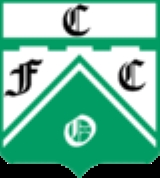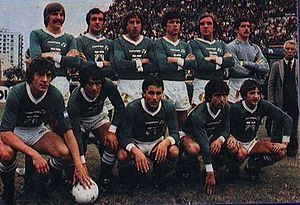
Ferro Carril Oeste
Encyclopedia
Club Ferro Carril Oeste, known simply as Ferro Carril Oeste or Ferro, is a sports club
from the neighbourhood of Caballito
, in Buenos Aires
, Argentina
. The club was founded on July 28, 1904 by 95 railway workers from the Buenos Aires Western Railway
. The club participates in many different sports with professional football, basketball
, and volleyball
(men's and women's) teams, and had a very prominent role in Argentine sports in the 1980s.
After the foundation, the board and workers of the railway company obtained from the company itself land to build a football stadium and other sports installations. At the end of the 1970s, Ferro had about 45,000 members.
Ferro is most prominent due to its football team, currently playing in the Primera B Nacional, the second division of the Argentine football league system
. Ferro won the Primera División on two occasions and the second division on 5.
in the final game. In 1947, the club was relegated to the second division, only to come back to the first division 2 years later.
Ferro had its golden age during the 80s', when obtaining two titles. The club also set three notable records in the Argentine Primera:
As a negative record, Ferro has the longest run without scoring a goal. The team went 875 minutes without scoring between the end of the 1998 Apertura and the 1999 Clausura.
The Buenos Aires Clásico del Oeste is played between Ferro and Vélez Sársfield
.

titles (1981, 1982, 1987).
In the early 1980s, Ferro was one of the best sides outside the NBA, and was managed by León Najnudel
, the man who thought up the current league.
Famous players: Miguel Cortijo, Luis Oroño, Sebastián Uranga, Javier Maretto, Diego Maggi, Daniel Aréjula, Horacio López, Luis Scola
, Erron Maxey
.
Famous players: Hugo Conte
, Waldo Kantor
, Esteban Martínez
, Carlos Getzelevich, Daniel Castellani
.
Sports club
A sports club or sport club, sometimes athletics club or sports association is a club for the purpose of playing one or more sports...
from the neighbourhood of Caballito
Caballito, Buenos Aires
Caballito is a barrio of the Argentine capital, Buenos Aires. It is the only barrio in the administrative division Comuna 6....
, in Buenos Aires
Buenos Aires
Buenos Aires is the capital and largest city of Argentina, and the second-largest metropolitan area in South America, after São Paulo. It is located on the western shore of the estuary of the Río de la Plata, on the southeastern coast of the South American continent...
, Argentina
Argentina
Argentina , officially the Argentine Republic , is the second largest country in South America by land area, after Brazil. It is constituted as a federation of 23 provinces and an autonomous city, Buenos Aires...
. The club was founded on July 28, 1904 by 95 railway workers from the Buenos Aires Western Railway
Buenos Aires Western Railway
The Buenos Aires Western Railway was one of the Big Four broad gauge British-owned companies that built and operated railway networks in Argentina...
. The club participates in many different sports with professional football, basketball
Basketball
Basketball is a team sport in which two teams of five players try to score points by throwing or "shooting" a ball through the top of a basketball hoop while following a set of rules...
, and volleyball
Volleyball
Volleyball is a team sport in which two teams of six players are separated by a net. Each team tries to score points by grounding a ball on the other team's court under organized rules.The complete rules are extensive...
(men's and women's) teams, and had a very prominent role in Argentine sports in the 1980s.
After the foundation, the board and workers of the railway company obtained from the company itself land to build a football stadium and other sports installations. At the end of the 1970s, Ferro had about 45,000 members.
Ferro is most prominent due to its football team, currently playing in the Primera B Nacional, the second division of the Argentine football league system
Argentine football league system
The Argentine football league system consists of two national divisions , and a series of regionalized lower divisions...
. Ferro won the Primera División on two occasions and the second division on 5.
Football
In 1907, Ferro joined the amateur second division, and in 1912 the team won the promotion to the first division after beating RacingRacing Club de Avellaneda
Racing Club is an Argentine professional football club from Avellaneda, a suburb of Greater Buenos Aires. Founded in 1903, Racing has been historically considered one of the "big five" clubs of Argentine football...
in the final game. In 1947, the club was relegated to the second division, only to come back to the first division 2 years later.
Ferro had its golden age during the 80s', when obtaining two titles. The club also set three notable records in the Argentine Primera:
- In the 1981 Metropolitano championship, goalkeeper Carlos BarisioCarlos BarisioCarlos José Barisio is a retired professional goalkeeper who retired from football in 1987, after amassing 271 appearances in the Argentinian Primera....
set a national record by keeping a clean sheet for 1,075 minutes of football. This included a run of 10 complete games without letting in a goal. - When Ferro won the 1982 Nacional championship, Ferro also achieved it without losing a single game. In addition, the club was the second team to achieve the feat after San Lorenzo. River PlateClub Atlético River PlateClub Atlético River Plate is an Argentine sports club based in the Nuñez neighborhood of Buenos Aires. It is best known for its professional football team, which currently competes in Nacional B, the second tier of Argentine football....
and Boca JuniorsBoca JuniorsClub Atlético Boca Juniors is an Argentine sports club based in La Boca neighborhood of Buenos Aires. It is best known for its professional football team, which currently plays in the Primera División....
also achieved this feat later in the 1990s.
As a negative record, Ferro has the longest run without scoring a goal. The team went 875 minutes without scoring between the end of the 1998 Apertura and the 1999 Clausura.
The Buenos Aires Clásico del Oeste is played between Ferro and Vélez Sársfield
Club Atlético Vélez Sársfield
Club Atlético Vélez Sársfield is a sports club based in the Liniers neighborhood of western Buenos Aires, Argentina. Vélez is best known for its football team, that plays in the Argentine Primera División, the top level of the Argentine league system...
.
Honours

- Primera División:
- Winners (2): 1982 Nacional, 1984 Nacional
- Second Division:
- Winners (5): 1912, 1958, 1963, 1970, 1978
- Primera B MetropolitanaPrimera B MetropolitanaPrimera B Metropolitana is one of two leagues that form the regionalized third level of the Argentine football league system. The other league at level three is the Torneo Argentino A....
:- Winners (1): 2002–03
Current squad
As of October 17, 2011.Basketball
The men's team plays in Buenos Aires' metropolitan league. Ferro won 3 Liga Nacional de Básquet (first division) championships (1985, 1986 and 1989) and 3 Campeonato Sudamericano de ClubesCampeonato Sudamericano de Clubes
The Campeonato Sudamericano de Clubes is an international men's basketball cup competition organized by the South American Basketball Confederation and played annually by invitee South American clubs.-Format:...
titles (1981, 1982, 1987).
In the early 1980s, Ferro was one of the best sides outside the NBA, and was managed by León Najnudel
León Najnudel
León David Najnudel was an Argentine basketball player and coach, and the main driving force in the creation of the Liga Nacional de Básquet, the first nationwide yearly professional basketball league in Argentina....
, the man who thought up the current league.
Famous players: Miguel Cortijo, Luis Oroño, Sebastián Uranga, Javier Maretto, Diego Maggi, Daniel Aréjula, Horacio López, Luis Scola
Luis Scola
Luis Alberto Scola Balvoa is an Argentine professional basketball player. The power forward-center for the Argentine national team is currently signed with the NBA's Houston Rockets. He formerly was a Euroleague star with the ACB's Saski Baskonia...
, Erron Maxey
Erron Maxey
Erron J. Maxey is an American professional basketball player.-High school:Maxey attended Temescal Canyon High School for two years. He was a standout for the basketball team carrying a height advantage over many opponents. Elsinore High School then acquired Maxey who was achieving great success in...
.
Men
Starts playing in 1953, and in 1960 arrived to first division.- First Division: 1977, 1980, 1981, 1983, 1984, 1985
- Copa Morgan: 1966, 1977, 1977, 1983, 1984, 1985, 1986
- South American Championship: 1987, 1998
Famous players: Hugo Conte
Hugo Conte
Hugo Néstor Conte is a volleyball coach and retired player from Argentina, who represented his native country in three Summer Olympics. He was born at Buenos Aires...
, Waldo Kantor
Waldo Kantor
Wáldo Ariel Kantor is a retired volleyball player from Argentina, who represented his native country at the 1984 Summer Olympics in Los Angeles, California and the 1988 Summer Olympics in Seoul. In Seoul, Kantor won the bronze medal with the men's national team.He started played soccer at All...
, Esteban Martínez
Esteban Martínez
Eduardo Esteban Martínez is a retired volleyball player from Argentina, who represented his native country in four Summer Olympics, starting in 1984 ....
, Carlos Getzelevich, Daniel Castellani
Daniel Castellani
Daniel Jorge Castellani is a former volleyball player from Argentina, who represented his native country in two Summer Olympics and now coaches both the Finland national side and Fenerbahçe Istanbul in Turkey....
.
Women
Started playing also in 1953 and reaches first division in 1957.- First Division: 1979, 1980, 1981, 1982, 1983, 1984, 1985, 1990
- Copa Morgan: 1977, 1978, 1980, 1981, 1983, 1984, 1986, 1987, 1988, 1998, 2004

